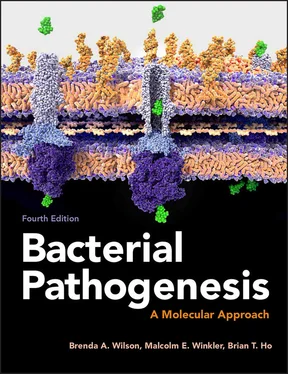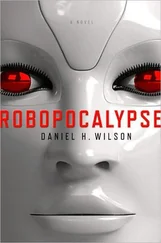Selected Readings
Questions
Solving Problems in Bacterial Pathogenesis
CHAPTER 14 Virulence Regulation
Virulence Gene Regulation
Mechanisms of Regulation
Operons, Regulons, and Global Regulators
Activators and Repressors
Two-Component Regulatory Systems
Sigma Factors
Transcriptional Terminators and Antiterminators
Regulation of Translation Initiation
Regulatory Small RNAs
Bacterial Chromatin
Responding to Environmental Signals
Phase Variation and Bistable Switches
Hypermutability, Intragenomic Recombination, and Positive Selection
Coordinate Virulence Regulation
Quorum Sensing
Chemotaxis
Selected Readings
Questions
Solving Problems in Bacterial Pathogenesis
Special Global Perspective Problems: Integrating Concepts in Pathogenesis
CHAPTER 15 Antimicrobial Compounds and Their Targets
Antimicrobial Compounds: The Safety Net of Modern Medicine
The Importance of Antimicrobial Compounds
Avoiding, Reducing, and Preventing Exposure
Killing versus Inhibiting Growth
Tests Used To Assess Antibiotics
Antiseptics and Disinfectants
Antibiotics
Characteristics of Antibiotics
The Process of Antibiotic Discovery
The Economics of Antibiotic Discovery
Mechanisms of Antibiotic Action
Targets of Antibiotic Action
Cell Wall Synthesis Inhibitors
Protein Synthesis Inhibitors
Antibiotics That Target DNA and RNA Synthesis
Inhibitors of Tetrahydrofolate Biosynthesis
The Newest Antibiotics
The Newest Antibiotic Targets
Strategies for Enhancing Antibiotic Efficacy
The Continuing Challenge
Selected Readings
Questions
Solving Problems in Bacterial Pathogenesis
CHAPTER 16 Antibiotic Resistance
The Dawning of Awareness—Uh, We Have a Problem!
How Did We Get to Where We Are?
And Now the Really Scary Part …
Emergence and Challenge of Multidrug Resistance (MDR)
Multiple Resistance and Genetic Linkage
Next-Generation MDR Pathogens: The “Superbugs”!
Mechanisms of Antibiotic Resistance
Overview of Resistance Mechanisms
Resistance to Antiseptics and Disinfectants
Limiting Access of the Antibiotic
Enzymatic Inactivation of the Antibiotic
Modification or Protection of the Antibiotic Target
Failure to Activate an Antibiotic
Regulation of Resistance Genes
Antibiotic Tolerance and Persister Cells
Antibiotic Tolerance
Persistence
Toxin-Antitoxin Systems
Horizontal Gene Transfer (HGT) of Resistance Genes
Propagating and Maintaining Antibiotic Resistance through Selective Pressure and Changes in Fitness
Will We Return to the Pre-Antibiotic Era?
Returning to Status Quo or Moving Forward?
The Hunt for Alternative Approaches to Antibiotics
Selected Readings
Questions
Solving Problems in Bacterial Pathogenesis
Special Global Perspective Problems: Integrating Concepts in Pathogenesis
CHAPTER 17 Vaccination: A Critical Component of the Modern Medical Armamentarium
Vaccines: A Major Health Care Bargain
What Makes an Ideal Vaccine?
Immunization Programs
Barriers to Implementation and Success of Immunization Programs
The Antivaccination Movement
Vaccine Success Stories
Subunit Vaccines
Conjugate Vaccines
Vaccine “Less-than-Success” Stories
A New Age of Vaccine Development: Making Vaccines Better
Approaches to Enhancing Immunogenicity
Adjuvants
Programming Adaptive Immunity
Targeting Mucosal Immunity
Storage of Vaccines—Strategies to Increase Shelf Life
Passive Immunization
Selected Readings
Questions
Solving Problems in Bacterial Pathogenesis
Special Global Perspective Problems: Integrating Concepts in Pathogenesis
CHAPTER 18 The Gram-Positive Opportunistic Pathogens
What Is an Opportunist?
Characteristics of Gram-Positive Opportunists
Notable Gram-Positive Opportunists
Staphylococcus aureus—Commensal Ready for a Fight
Staphylococcus epidermidis—Accidental Pathogen
Streptococcus pneumoniae—“Captain of All the Men of Death”
Clostridium difficile—True Opportunist
Other Gram-Positive Opportunists
Selected Readings
Questions
Solving Problems in Bacterial Pathogenesis
CHAPTER 19 The Gram-Negative Opportunistic Pathogens
Jumping Over the (Cell) Wall: Gram-Negative Bacteria Can Be Opportunistic Pathogens Too!
Common Traits of Gram-Negative Opportunists
The Dark Side of Some Residents of the Human Body
The Ever-Changing Face of E. coli
Klebsiella pneumoniae Nosocomial Infections
Bacteroides fragilis—The Bad Sheep of the Family
Porphyromonas gingivalis—A Keystone Pathogen
Environmental Inhabitants Weigh in as Opportunists
Pseudomonas aeruginosa—A Versatile Opportunist of the Highest Order
Burkholderia cepacia Complex—P. aeruginosa’s Evil Twin
Acinetobacter baumannii—A Deadly Threat Emerges from the Iraq War
Don’t Forget the Arthropods!
Ehrlichia spp.
Selected Readings
Questions
Solving Problems in Bacterial Pathogenesis
Special Global Perspective Problems: Integrating Concepts in Pathogenesis
CHAPTER 20 The Changing Roles of Microbiologists in an Age of Bioterrorism and Emerging Diseases
When Microbiologists Are Called to the Front Line
Tracking Down a Bioterrorist
Unintentional or Deliberate?
Timing
Tracing the Source
Lessons Learned
The “Top Four” Bioterror Agents
Bacillus anthracis Spores
Smallpox
Yersinia pestis
Botulinum Neurotoxin
What If Bioterrorists Hit Us with Something Completely New?
Biosecurity in a Complex, Dynamic, and Ever-Changing World
Food Safety and Biosecurity
The Case for Food Irradiation
The Future of Biosecurity
Selected Readings
Questions
Solving Problems in Bacterial Pathogenesis
Glossary
Index
Preface
Since the third edition of Bacterial Pathogenesis: A Molecular Approach was written, the field of bacterial pathogenesis has vastly expanded and evolved. Some areas have been revolutionized by the manner that research is now conducted in this genome era and the wealth of information obtained from modern advanced technologies, while other areas have become obsolete. These changes have necessitated extensive updating and rewriting of many chapters of the textbook. The death of Abigail Salyers and the retirement of Dixie Whitt in 2013 necessitated the recruitment of a new author, Brian Ho, who like the other remaining authors, Brenda Wilson and Malcolm Winkler, comes with significant expertise and research experience in modern approaches to studying bacterial pathogenesis.
This textbook is intended to be a living book that evolves in response to the constantly changing research landscape of the field of bacterial pathogenesis. True to this mandate, the fourth edition maintains the overall format of the third edition, building on the core foundations and insights of the previous editions, while expanding into new concepts, key modern innovations and cutting-edge research, and new developments in the field. All-new detailed illustrations, for the first time in stunning full color, depict important concepts and mechanisms by which bacterial pathogens interact with their hosts, other microbes, and their environments, both inside and outside the body. The enormous advances that have been made in next-generation sequencing technologies and functional genomics and multi-omics approaches have necessitated a complete update for several of the chapters. Expanded topics highlight new developments in the areas of microbiomes; comparative and evolutionary genomics; the power of Tn-Seq, RNA-Seq, and gene-editing technologies; the advancing areas of autophagy, CRISPR-Cas systems, and transgenic animal models; the roles of secreted effectors and innate immunity in pathogen clearance and persistence; and the escalating challenges of antimicrobial resistance.
Читать дальше












